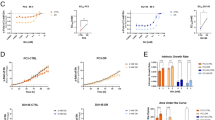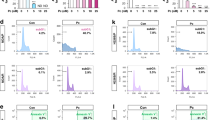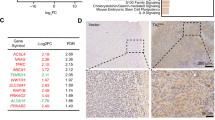Abstract
Glucose-6-phosphate dehydrogenase-deleted embryonic stem (ES) cells (G6pdΔ) proliferate in vitro without special requirements, but when challenged with oxidants fail to sustain glutathione disulphide reconversion to reduced glutathione (GSH), entering a condition of oxidative stress. Here, we investigate the signalling events downstream of GSH oxidation in G6pdΔ and wild-type (wt) ES cells. We found that G6pdΔ ES cells are very sensitive to oxidants, activating an apoptotic pathway at oxidant concentrations otherwise sublethal for wt ES cells. We show that the apoptotic pathway activated by low oxidant concentrations is accompanied by mitochondria dysfunction, and it is therefore blocked by the overexpression of Bcl-XL. Bcl-XL does not inhibit the decrease in cellular GSH and reactive oxygen species formation following oxidant treatment. We also found that oxidant treatment in ES cells is followed by the activation of the MEK/extracellular signal-regulated kinase (ERK) pathway. Interestingly, ERK activation has opposite outcomes in G6pdΔ ES cells compared to wt, which has a proapoptotic function in the first and a prosurvival function in the latter. We show that this phenomenon can be regulated by the cellular GSH level.
Similar content being viewed by others
Log in or create a free account to read this content
Gain free access to this article, as well as selected content from this journal and more on nature.com
or
Change history
12 January 2023
This article has been retracted. Please see the Retraction Notice for more detail: https://doi.org/10.1038/s41418-022-01111-y
Abbreviations
- CisPt:
-
cisplatin
- ERK:
-
extracellular signal-regulated kinases
- G6PD:
-
glucose 6-phosphate dehydrogenase
- Gox:
-
glucose oxidase
- GPX:
-
glutathione peroxidase
- GSH:
-
reduced glutathione
- GSSG:
-
glutathione disulphide
- H2O2:
-
hydrogen peroxide
- JNK:
-
c-Jun N-terminal kinases
- MAPK:
-
mitogen-activated protein kinases
- Mq:
-
menadione
- NAC:
-
N-acetyl cysteine
- NADPH:
-
reduced nicotinamide adenine dinucleotide
- PARP:
-
poly(ADP-ribose) polymerase
- PPP:
-
pentose phosphate pathway
- ROS:
-
reactive oxygen species
- SOD:
-
superoxide dismutase
References
Cory S and Adams JM (2002) The Bcl2 family: regulators of the cellular life-or-death switch. Nat. Rev. Cancer. 2: 647–656
Gross A, McDonnell JM and Korsmeyer SJ (1999) BCL-2 family members and the mitochondria in apoptosis. Genes Dev. 13: 1899–1911
Vander Heiden MG and Thompson CB (1999) Bcl-2 proteins: regulators of apoptosis or of mitochondrial homeostasis? Nat. Cell Biol. 1: E209–216
Finkel T (2000) Redox-dependent signal transduction. FEBS Lett. 476: 52–54
Martindale JL and Holbrook NJ (2002) Cellular response to oxidative stress: signaling for suicide and survival. J. Cell. Physiol. 192: 1–15
Stryer L (1995) Biochemistry. New York: W.H. Freeman and Company
Lotharius J and Brundin P (2002) Pathogenesis of Parkinson's disease: dopamine, vesicles and alpha-synuclein. Nat. Rev. Neurosci. 3: 932–942
Brownlee M (2001) Biochemistry and molecular cell biology of diabetic complications. Nature 414: 813–820
Behl C and Moosmann B (2002) Oxidative nerve cell death in Alzheimer's disease and stroke: antioxidants as neuroprotective compounds. Biol. Chem. 383: 521–536
Kolch W. (2000) Meaningful relationships: the regulation of the Ras/Raf/MEK/ERK pathway by protein interactions. Biochem. J. 351 (Part 2): 289–305
Johnson GL and Lapadat R (2002) Mitogen-activated protein kinase pathways mediated by ERK, JNK, and p38 protein kinases. Science 298: 1911–1912
Cuda G, Paterno R, Ceravolo R, Candigliota M, Perrotti N, Perticone F, Faniello MC, Schepis F, Ruocco A, Mele E, Cassano S, Bifulco M, Santillo M and Avvedimento EV (2002) Protection of human endothelial cells from oxidative stress: role of Ras-ERK1/2 signaling. Circulation 105: 968–974
Longo L, Vanegas OC, Patel M, Rosti V, Li H, Waka J, Merghoub T, Pandolfi PP, Notaro R, Manova K and Luzzatto L (2002) Maternally transmitted severe glucose 6-phosphate dehydrogenase deficiency is an embryonic lethal. EMBO J. 21: 4229–4239
Pandolfi PP, Sonati F, Rivi R, Mason P, Grosveld F and Luzzatto L (1995) Targeted disruption of the housekeeping gene encoding glucose 6-phosphate dehydrogenase (G6PD): G6PD is dispensable for pentose synthesis but essential for defense against oxidative stress. EMBO J. 14: 5209–5215
Filosa S, Fico A, Paglialunga F, Balestrieri M, Crooke A, Verde P, Abrescia P, Bautista JM and Martini G (2003) Failure to increase glucose consumption through the pentose-phosphate pathway results in the death of glucose-6-phosphate dehydrogenase gene-deleted mouse embryonic stem cells subjected to oxidative stress. Biochem. J. 370: 935–943
Kosower NS and Kosower EM (1995) Diamide: an oxidant probe for thiols. Methods Enzymol. 251: 123–133
Zehavi-Willner T, Kosower EM, Hunt T and Kosower NS. (1971) Glutathione. V. The effects of the thiol-oxidizing agent diamide on initiation and translation in rabbit reticulocytes. Biochim. Biophys. Acta 228: 245–251
Gardner AM, Xu FH, Fady C, Jacoby FJ, Duffey DC, Tu Y and Lichtenstein A (1997) Apoptotic vs. nonapoptotic cytotoxicity induced by hydrogen peroxide. Free Radic. Biol. Med. 22: 73–83
Hockenbery DM, Oltvai ZN, Yin XM, Milliman CL and Korsmeyer SJ (1993) Bcl-2 functions in an antioxidant pathway to prevent apoptosis. Cell 75: 241–251
Tian WN, Braunstein LD, Apse K, Pang J, Rose M, Tian X and Stanton RC (1999) Importance of glucose-6-phosphate dehydrogenase activity in cell death. Am. J. Physiol. 276: C1121–1131
Gordon GB, Shantz LM and Talalay P (1987) Modulation of growth, differentiation and carcinogenesis by dehydroepiandrosterone. Adv. Enzyme Regul. 26: 355–382
Salvemini F, Franze A, Iervolino A, Filosa S, Salzano S and Ursini MV (1999) Enhanced glutathione levels and oxidoresistance mediated by increased glucose-6-phosphate dehydrogenase expression. J. Biol. Chem. 274: 2750–2757
Gottlob K, Majewski N, Kennedy S, Kandel E, Robey RB and Hay N (2001) Inhibition of early apoptotic events by Akt/PKB is dependent on the first committed step of glycolysis and mitochondrial hexokinase. Genes Dev. 15: 1406–1418
Plas DR, Talapatra S, Edinger AL, Rathmell JC and Thompson CB (2001) Akt and Bcl-xL promote growth factor-independent survival through distinct effects on mitochondrial physiology. J. Biol. Chem. 276: 12041–12048
Le Goffe C, Vallette G, Jarry A, Bou-Hanna C and Laboisse CL (1999) The in vitro manipulation of carbohydrate metabolism: a new strategy for deciphering the cellular defence mechanisms against nitric oxide attack. Biochem. J. 344 (Part 3): 643–648
Flohe L, Brigelius-Flohe R, Saliou C, Traber MG and Packer L (1997) Redox regulation of NF-kappa B activation. Free Radic. Biol. Med. 22: 1115–1126
Polyak K, Xia Y, Zweier JL, Kinzler KW and Vogelstein B (1997) A model for p53-induced apoptosis. Nature 389: 300–305
Schreck R, Rieber P and Baeuerle PA (1991) Reactive oxygen intermediates as apparently widely used messengers in the activation of the NF-kappa B transcription factor and HIV-1. EMBO J. 10: 2247–2258
Blanchetot C, Tertoolen LG and den Hertog J (2002) Regulation of receptor protein-tyrosine phosphatase alpha by oxidative stress. EMBO J. 21: 493–503
Casagrande S, Bonetto V, Fratelli M, Gianazza E, Eberini I, Massignan T, Salmona M, Chang G, Holmgren A and Ghezzi P (2002) Glutathionylation of human thioredoxin: a possible crosstalk between the glutathione and thioredoxin systems. Proc. Natl. Acad. Sci. USA 99: 9745–9749
Fratelli M, Demol H, Puype M, Casagrande S, Eberini I, Salmona M, Bonetto V, Mengozzi M, Duffieux F, Miclet E, Bachi A, Vandekerckhove J, Gianazza E and Ghezzi P (2002) Identification by redox proteomics of glutathionylated proteins in oxidatively stressed human T lymphocytes. Proc. Natl. Acad. Sci. USA 99: 3505–3510
Beutler E (1991) Glucose-6-phosphate dehydrogenase deficiency. N. Engl. J. Med. 324: 169–174
Luzzatto L. (1975) Inherited haemolytic states: glucose-6-phosphate dehydrogenase deficiency. Clin. Haematol. 4: 83–108
Robertson EJ (1987) Embryo-derived stem cell lines. In Teratocarcinomes and Embryonic Stem Cells: A Practical Approach, Robertson EJ (ed) (Oxford, UK: IRL Press) pp. 71–112
Acknowledgements
We thank J Downward and D Hancock for their critical review of the paper, D De Cesare and L Casalino for support and advice, C Rallo, M Petrillo and S Cossu for help with the computer work and C Sole, M Terracciano and R Vito for their skilful laboratory assistance. This work was supported by the Italian Telethon Foundation, Grant No. 324/bi and Progetto MURST-CNR Legge 488/92 (Cluster C02).
Author information
Authors and Affiliations
Corresponding author
Additional information
Edited by G Melino
About this article
Cite this article
Fico, A., Paglialunga, F., Cigliano, L. et al. RETRACTED ARTICLE: Glucose-6-phosphate dehydrogenase plays a crucial role in protection from redox-stress-induced apoptosis. Cell Death Differ 11, 823–831 (2004). https://doi.org/10.1038/sj.cdd.4401420
Received:
Revised:
Accepted:
Published:
Issue date:
DOI: https://doi.org/10.1038/sj.cdd.4401420
Keywords
This article is cited by
-
RNA sequencing profiles reveal dynamic signaling and glucose metabolic features during bone marrow mesenchymal stem cell senescence
Cell & Bioscience (2022)
-
Combination treatment of docetaxel with caffeic acid phenethyl ester suppresses the survival and the proliferation of docetaxel-resistant prostate cancer cells via induction of apoptosis and metabolism interference
Journal of Biomedical Science (2022)
-
Mitochondrial dysfunction is a key pathological driver of early stage Parkinson’s
Acta Neuropathologica Communications (2022)
-
Reduced nicotinamide adenine dinucleotide phosphate in redox balance and diseases: a friend or foe?
Acta Pharmacologica Sinica (2022)
-
In vitro production of desired sex ovine embryos modulating polarity of oocytes for sex-specific sperm binding during fertilization
Scientific Reports (2022)



